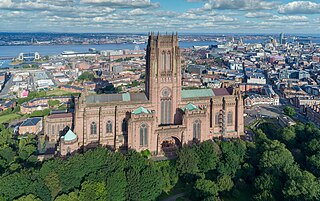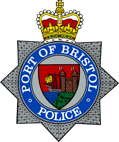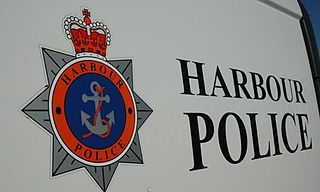
The River Mersey is a major river in North West England. Its name derives from Old English and means "boundary river", possibly referring to its having been a border between the ancient kingdoms of Mercia and Northumbria. For centuries it has formed part of the boundary between the historic counties of Lancashire and Cheshire.

The Manchester Ship Canal is a 36 mi-long (58 km) inland waterway in the North West of England linking Manchester to the Irish Sea. Starting at the Mersey Estuary at Eastham, near Ellesmere Port, Cheshire, it generally follows the original routes of the rivers Mersey and Irwell through the historic counties of Cheshire and Lancashire. Several sets of locks lift vessels about 60 ft (18 m) to the canal's terminus in Manchester. Landmarks along its route include the Barton Swing Aqueduct, the world's only swing aqueduct, and Trafford Park, the world's first planned industrial estate and still the largest in Europe.

Transit police are specialized police agencies employed either by a common carrier, such as a transit district, railway, railroad, bus line, or another mass transit provider or municipality, county, district, or state.

Salisbury Dock is a dock on the River Mersey, England, and part of the Port of Liverpool. It is situated in the northern dock system in Vauxhall and is connected to Nelson Dock to the north, Trafalgar Dock to the south and inland to Collingwood Dock.

Manchester Dock was a dock on the River Mersey in England and a part of the Port of Liverpool. The dock was not part of the interconnected dock system, but was connected directly to the river.

The Mersey Docks and Harbour Company (MDHC), formerly the Mersey Docks and Harbour Board (MDHB), owns and administers the dock facilities of the Port of Liverpool, on the River Mersey, England. These include the operation of the enclosed northern dock system that runs from Prince's Dock to Seaforth Dock, in the city of Liverpool and the dock facilities built around the Great Float of the Wirral Peninsula, located on the west side of the river.

Queen Elizabeth II Dock is a dock situated on the River Mersey at Eastham, in the Metropolitan Borough of Wirral, Merseyside, England.

The Mersey Tunnels Police is a small, specialised, non-Home Office police force that provides policing services for the Mersey Tunnels in Merseyside, England. The force, which comprises fifty one officers from Constable to Chief Police Officer is responsible for effective road policing of the Mersey Tunnels, Approach Roads and Exit Roads. It is privately funded by Merseytravel which in turn reports to the Liverpool City Region Combined Authority.

Merseyside Police is the territorial police force responsible for policing Merseyside in North West England. The service area is 647 square kilometres with a population of around 1.5 million. As of September 2017 the service has 3,484 police officers, 1,619 police staff, 253 police community support officers, 155 designated officers and 208 special constables. The force is led by Chief Constable Serena Kennedy.

Liverpool City Region is a combined authority area in North West England. It has six council areas; five Merseyside metropolitan boroughs and the Cheshire unitary authority of Halton. The region had a population of 1,571,045 in 2022.

The Belfast Harbour Police is a small, specialised ports police force, with responsibility for the Port of Belfast, Northern Ireland. It was founded in 1847, making it the oldest continuously-operating law enforcement agency on the island of Ireland.

The Port of Dover Police (PoDP) is a non-Home Office ports police force which provides a 24-hour policing service to the Port of Dover, Kent, England.

The Port of Bristol Police (PoBP) is a ports police force with responsibility to protect the port complexes and community situated at the mouth of the River Avon on the border between Bristol and Somerset. Officers are attested under powers in legislation derived from the Harbours, Docks and Piers Clauses Act 1847.

Tees and Hartlepool Harbour Police is a non-Home Office ports police force responsible for Teesport, which is the UK's third largest port and is owned by PD Ports, situated along the south bank of the River Tees in north east England. The harbour police force is over 100 years old and was originally formed under the Harbour, Docks and Piers Clauses Act 1847.

The Port of Portland Police is a non-Home Office ports police force responsible for the Port of Portland in Dorset, United Kingdom.
Liverpool in North West England, is a major British city with significant road, rail, and ferry networks, in addition to an international airport and a well-known dock system. As with most other major UK cities, Liverpool's transport infrastructure is centred on its road and rail networks. Public transport services within the city are controlled and run by Merseytravel.

Manchester Ship Canal Police was a police force in the United Kingdom that was responsible for policing the Manchester Ship Canal. It was maintained by the Manchester Ship Canal Company between 26 December 1893, when the canal opened, and 31 January 1993.
Atlantic Gateway, sometimes referred to as Ocean Gateway, is a proposed redevelopment strategy for North West England, centering on the corridor between Greater Manchester and Merseyside. The proposal is for development backed by £50 billion of investment over 50 years, making it one of the most expensive and expansive development projects in UK history.























